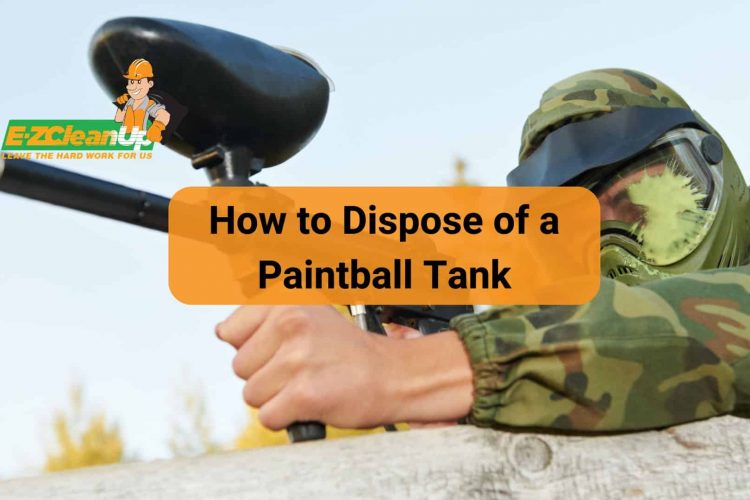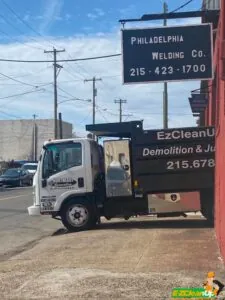For an eco-conscious disposal of paintball tanks, first ensure the tank is completely empty. Then, safely remove its valve or cut it in half, if required, to facilitate recycling. This method allows for aluminum or steel tanks to be repurposed responsibly at local recycling centers.
If you are interested in the details and ways of how to dispose of a paintball tank, read our guide below.
Ways to Handle Paintball Tank Disposal
When it comes to disposing of paintball tanks, it’s crucial to handle the process with care to ensure safety, compliance with regulations, and environmental protection.
Recycling Options
Recycling is a preferred method for disposing of empty paintball CO2 tanks, which are typically made of recyclable materials like aluminum or steel. After ensuring the tank is completely empty, you can take it to a local recycling center that accepts these materials.
Some centers may require the removal of the valve or even ask that the cylinder be cut in half to ensure it’s safe for recycling. This process helps reduce waste and supports environmental sustainability efforts.
Specialized Disposal Services
For tanks that cannot be recycled due to damage or safety concerns, specialized disposal services offer a viable alternative. These services are equipped to handle potentially hazardous materials safely.
Before disposing of a tank, ensure it’s empty to avoid any risk of explosion or injury. If you’re unsure about local services, contacting your municipal waste management department can provide you with the necessary information and guidelines for safe disposal.
Returning to the Manufacturer or Retailer
Another responsible way to dispose of your paintball tank is by returning it to the manufacturer or retailer from where it was purchased. Many manufacturers and retailers offer take-back programs for used tanks. This ensures they are either refurbished and reused or disposed of in an environmentally friendly manner.
Alternatives to Disposal
When it comes to handling paintball tanks that you’re not ready to dispose of, there are several responsible and creative alternatives to simply throwing them away. Each option offers a sustainable approach that reduces waste while promoting a circular economy.
Refilling and Reusing
Refilling your paintball CO2 or air tanks is a practical option. Most paintball tanks are designed to be refillable, with facilities available at local paintball stores, arenas, and even some sporting goods stores.
The process involves special equipment like heavy-duty compressors for air tanks and, for CO2 tanks, a bulk source of CO2 and a fill station. It’s essential to have a basic understanding of the equipment and the process to ensure safety. Some local shops, including sporting goods stores and places that fill fire extinguishers, offer refilling services for both CO2 and HPA tanks.
Donation for Training or Education
Donating your old paintball tanks to local paintball clubs, youth groups, or educational programs that offer training in paintball sports can be a meaningful way to repurpose them. These organizations often appreciate donations that help reduce their equipment costs and allow them to use these tanks in safe, supervised settings.
They use the tanks to educate newcomers about the sport and equipment maintenance, including safe refilling practices.
Upcycling or Repurposing Ideas
For the creatively inclined, upcycling or repurposing paintball tanks into new items is a great way to give them a second life. Ideas range from transforming them into unique pieces of art or furniture to practical uses in DIY projects.
However, it’s crucial to ensure the tank is completely empty and safe to work with before starting any project. Upcycling not only prevents waste but can also result in one-of-a-kind items with personal value.
Preparing Paintball Tanks for Disposal
Disposing of a paintball tank, especially one that’s been a loyal part of your gear, involves a few careful steps to ensure safety and environmental responsibility. Here’s a guide to help you prepare your paintball tanks for proper disposal.
Emptying the Tank
The first step is crucial: emptying the tank. Since paintball tanks contain CO2 under high pressure, they can pose serious risks if handled improperly.
There are two safe methods to empty your tank. You can attach it to your paintball gun, remove any paintballs, and fire in a safe direction until no more gas is released. Alternatively, if you cannot use your gun, manually release the gas by pressing the valve at the top of the tank.
Remember, this must be done in a well-ventilated area while wearing gloves to avoid frostbite from the cold gas.
Detaching the Tank from the Paintball Gun
Once the tank is empty, detach it from the paintball gun. Do it gently to avoid damaging the gun’s air system or the tank’s threading. Ensuring that the tank is completely disconnected and all pressure has been released is crucial before moving on to disposal.
Checking for Damage and Wear
Before disposing of the tank, inspect it for any signs of damage or wear. Look for dents, corrosion, or any damage that might have occurred during use. This step is important for determining the best disposal method.
If the tank is damaged, it might not be suitable for recycling or resale and should be handled with extra care to avoid safety risks.
Reasons for Disposing of Paintball Tanks
Disposing of paintball tanks involves addressing safety concerns, environmental considerations, and adhering to legal and regulatory requirements.
Safety Concerns
Safety is the primary reason for the disposal or re-testing of paintball tanks. Over time, tanks can suffer from wear and tear, which leads to potential hazards. Hydro-testing, a process that assesses the tank’s ability to withstand pressures, is mandated every 3-5 years for CO2 and HPA (High-Pressure Air) tanks to prevent dangerous failures.
A failed hydro test indicates that a tank is no longer safe for use and must be disposed of. This is because reusing a compromised tank poses significant risks, including the possibility of an explosion due to overpressure or internal damage.

Environmental Considerations
Environmental responsibility is another critical factor in the disposal of paintball tanks. Improper disposal can lead to pollution and harm wildlife and ecosystems. Moreover, the production and disposal of CO2, a greenhouse gas, from paintball tanks contribute to climate change.
Transitioning to HPA tanks from CO2 tanks has been encouraged within the paintball community. This is not only for performance reasons but also for their lower environmental impact since HPA systems are refillable and don’t emit CO2.
Legal and Regulatory Requirements
Legal and regulatory frameworks also guide the disposal and testing of paintball tanks. The responsible regulatory bodies have set forth guidelines that include hydro-testing schedules and disposal protocols to ensure public safety and environmental protection.
Non-compliance with these regulations not only endangers individuals and the environment but can also lead to legal repercussions for tank owners and paintball fields.
Safety Tips for Handling and Disposal
Disposing of a paintball tank, especially one that contains CO2, requires careful attention to safety for both the individual handling the tank and the environment. Here are some safety tips and guidelines to ensure proper handling and disposal:
Protective Gear and Precautions
When preparing to dispose of your paintball tank, wearing protective gear is crucial to preventing injuries. Gloves are essential to protect your hands from frostbite when releasing CO2 gas, which can be extremely cold.
If you’re emptying the tank manually, using a screwdriver or another long-handled tool to press the discharge valve is advised to keep a safe distance from the escaping gas. Ensure this process is carried out in a well-ventilated area to prevent CO2 buildup, which could lead to asphyxiation.

Avoiding DIY Disposal Methods
It’s important to avoid DIY disposal methods that could cause the tank to become a projectile or explode, such as puncturing or crushing it. Instead, focus on safely emptying the tank before considering disposal options. If you’re unsure about how to safely discharge the tank, seek professional help rather than attempting it yourself.
Paintball Tank Disposal: Aim for Safety
Disposing of a paintball tank involves careful steps to ensure safety and compliance, a task often intimidating for many. While EZ CleanUp doesn’t handle hazardous waste like paintball tanks, for all other junk removal needs, we’re here to efficiently and responsibly clear the clutter.
Contact specialists for hazardous waste, and let us take care of the rest. Reach out to us for a cleaner space!














